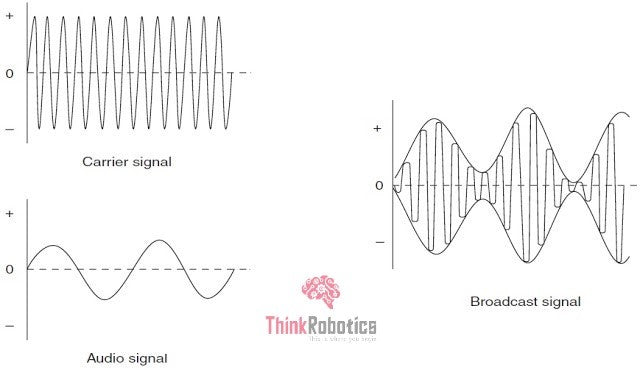Modulation of a signal is a widely used phenomenon in telecommunication and electronics.
Going by the definition the Modulation, is a technique for impressing information (voice, music, picture, or data) on a radio-frequency carrier wave by varying one or more characteristics of the wave by the intelligence signal or the signal carrying the information.
It is typically the process of encoding information from a message source in a suitable way for transmission.
There are many types of Modulation, each designed to alter a specific characteristic of the carrier wave. The most commonly altered characteristics are amplitude, frequency, phase, pulse sequence, and pulse duration.

The carrier wave, usually a high-frequency wave used to carry the information wave, as mentioned earlier, can travel up to a longer distance without getting affected by external disturbances, thus called so.
So altogether, this process involves:
- The MESSAGE SIGNAL or modulating signal that is supposed to be transmitted,
- The CARRIER SIGNAL, which undergoes alterations and whose main aim is to carry the message signal to the receiver end
- Moreover, the MODULATED SIGNAL or the broadcasted signal combines the modulating signal and the carrier signal.
Need for Modulation:
However, the question arises as to why do we need modulation in the first place? Can’t we send the message signal over the distance while receiving it at the other end?
- NO, the information/modulating signals are unsuited for direct transmission. For this reason, their strength is increased by modulating them with a high-frequency carrier wave, which does not affect the parameters of the modulating signal.
- The antennas' size to send and receive a signal depends on the signal's Wavelength, and the Wavelength and frequency vary inversely concerning each other. The audio or video signals, also called the baseband signals to hold low frequencies in the Electromagnetic spectrum.
Wavelength (λ) = Speed of Light (c) / Frequency (ϑ)
Speech frequencies range from 20 Hz to 20 kHz. Suppose a frequency of 18 kHz and it is transmitted out to a receiver through a channel of free space. The size of the antenna in terms of its length can vaguely be obtained as:
Length(L) = Wavelength (λ) = Speed of Light (c) / Frequency (ϑ)
= 3 * 10^8 / 18 * 10^8 = 16.66 km
With the low frequency and high wavelengths of the baseband signals, the size (length) of the antennas is not practical (in kilometres), like in this case.
When we use the high-frequency carrier signal to transmit the baseband signal, the frequency of the overall modulated or the broadcasted signal increases, this makes its wavelength lower, resulting in practical and feasible sizes(lengths) of the antennas.
- In Modulation, various frequencies are allotted with a fixed band or range. This is useful, as it completely cuts down the interference of two signals, thus razes the noise. For example, Wi-Fi uses individual channels to simultaneously transmit data to and from multiple clients with the help of Modulation. Now you know why you get noise interference over a phone call at times. Modulation aims at eradicating such noises to give us a better experience.
- By Modulation, the bandwidth can be increased by the introduction of upper and lower sidebands. Frequency-division multiplexing is a practice by which the total bandwidth available in a communication channel is divided into a series of non-overlapping frequency bands, where each one is like a carrier signal, used to carry a separate modulating call. This allows a single transmission medium like a cable or optical fibre to be shared by multiple independent signals.
Thus, the technique of Modulation is used to increase the reach of the signals. It’s used everywhere, be it wired /wireless communication or cellular / WI-FI network. Modulation makes the signal usable and maintains its quality.
Sources:
- tutorialspoint.com/principles_of_communication/principles_of_communication_modulation.htm
- britannica.com/technology/modulation-communications
- quora.com/Why-do-we-need-modulation
- byjus.com/physics/what-is-modulation-why-do-we-need-it/
- en.wikipedia.org/wiki/Modulation#:~:text=In%20electronics%20and%20telecommunications%2C%20modulation,contains%20information%20to%20be%20transmitted.
- images.app.goo.gl/TB92vpUdZUti8KJH9

